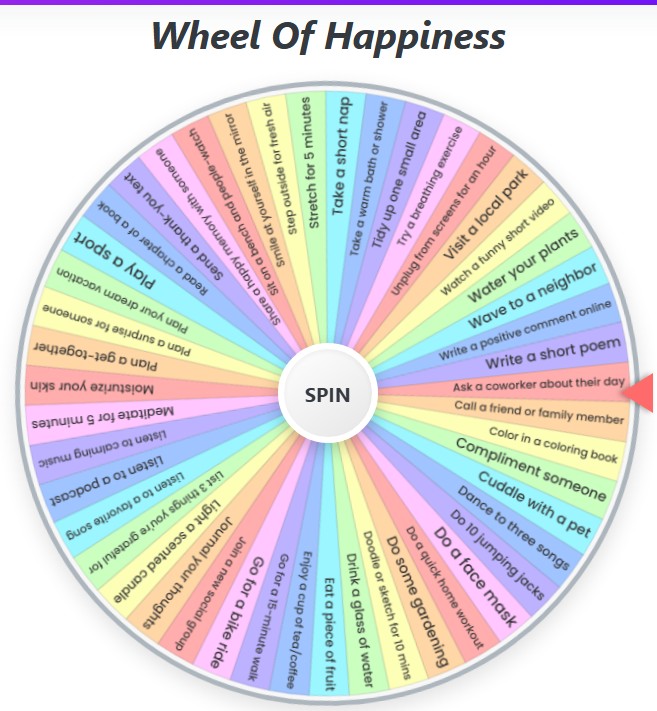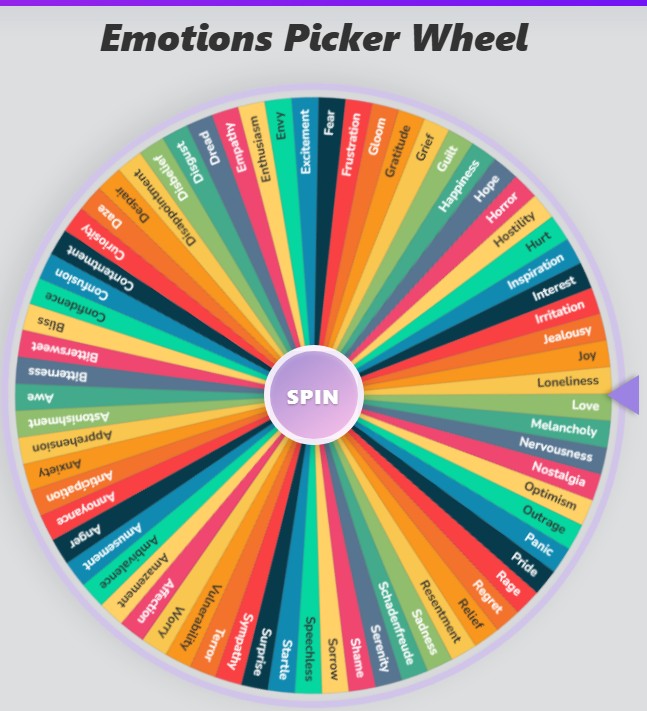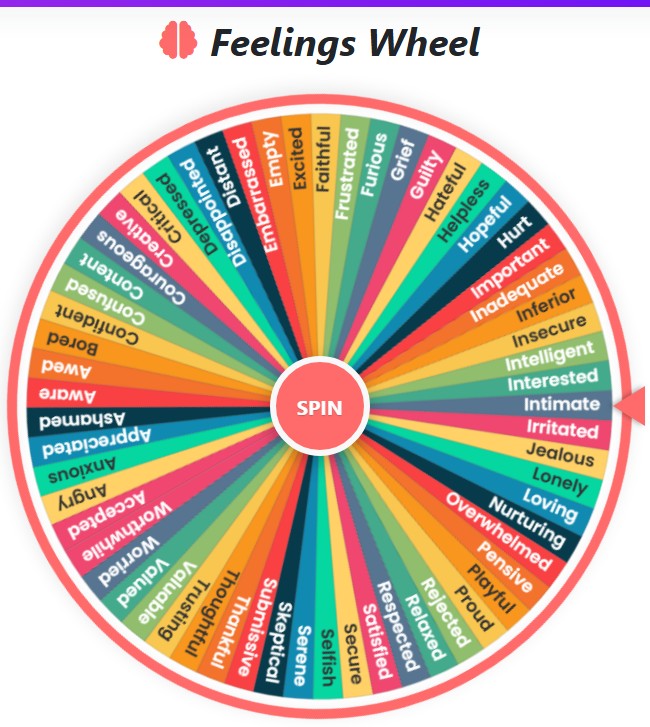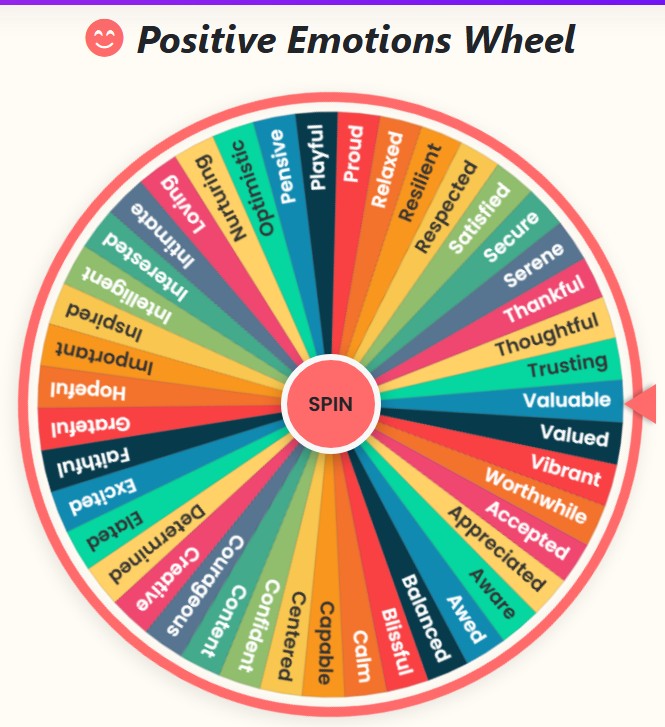100+ Strong Emotions Wheel
Current Mode: None
Quick link:
- The 5 Love Language Wheel
- anger emotions wheel
- Sad emotion wheel
- Positive Emotions Wheel
- 60 Feelings Picker Wheel – Spin & Discover
- 70 Emotion Picker Wheel – Spin & Discover Feelings
Unlock Your Feelings: The Ultimate Guide to the 100+ Strong Emotions Wheel
Ever felt a storm of feelings inside but couldn’t find the right word for it? 🤔 You’re not alone. Navigating the complex world of our inner selves can be challenging. That’s where the strong emotions wheel comes in—a powerful, interactive tool designed to help you identify, explore, and understand the vast spectrum of human feeling.
This guide will walk you through everything you need to know to become a master of this incredible tool. But first, let’s explore the incredible range of emotions waiting for you.
Explore the Spectrum of Feeling
Right at the heart of the strong emotions wheel are over 125 distinct feelings, neatly organized into eight core categories. This list is your new emotional vocabulary.
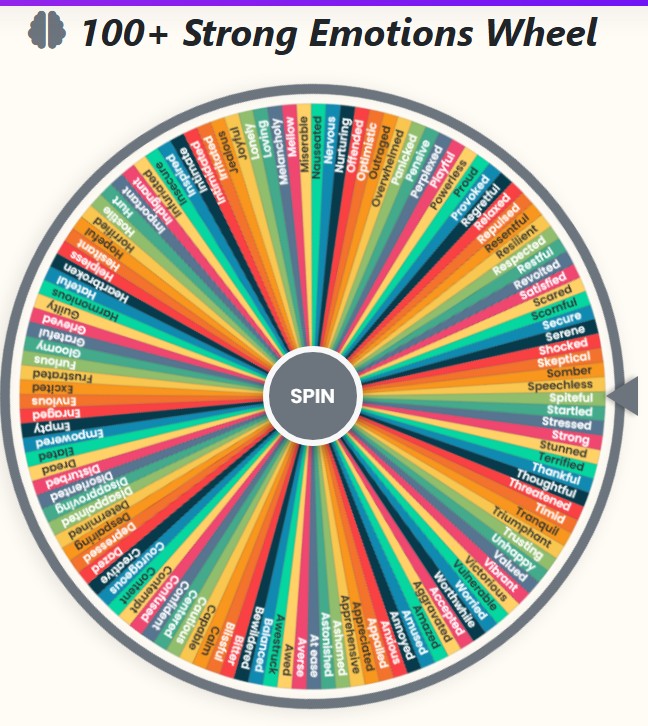
Happy Emotions
- Joyful
- Content
- Proud
- Accepted
- Awed
- Excited
- Hopeful
- Creative
- Elated
- Optimistic
- Vibrant
- Blissful
- Loving
- Thankful
- Grateful
- Serene
- Playful
- Amused
Sad Emotions
- Disappointed
- Miserable
- Depressed
- Unhappy
- Lonely
- Heartbroken
- Grieved
- Melancholy
- Despairing
- Regretful
- Guilty
- Ashamed
- Somber
- Gloomy
- Hurt
- Empty
- Vulnerable
- Powerless
Angry Emotions
- Furious
- Enraged
- Irritated
- Annoyed
- Frustrated
- Resentful
- Bitter
- Jealous
- Envious
- Offended
- Aggravated
- Hostile
- Hateful
- Spiteful
- Infuriated
- Indignant
- Provoked
- Outraged
Fearful Emotions
- Scared
- Anxious
- Insecure
- Terrified
- Panicked
- Nervous
- Worried
- Apprehensive
- Dread
- Helpless
- Overwhelmed
- Stressed
- Threatened
- Intimidated
- Horrified
- Timid
- Cautious
- Startled
Powerful Emotions
- Confident
- Capable
- Resilient
- Determined
- Inspired
- Courageous
- Victorious
- Triumphant
- Valued
- Respected
- Important
- Appreciated
- Worthwhile
- Satisfied
- Empowered
- Strong
Peaceful Emotions
- Calm
- Relaxed
- Secure
- Centered
- Balanced
- Tranquil
- At ease
- Thoughtful
- Pensive
- Trusting
- Intimate
- Nurturing
- Harmonious
- Mellow
- Restful
Surprised Emotions
- Shocked
- Astonished
- Amazed
- Awestruck
- Dazed
- Confused
- Bewildered
- Speechless
- Stunned
- Startled
- Disoriented
- Perplexed
Disgusted Emotions
- Repulsed
- Contempt
- Revolted
- Disapproving
- Averse
- Scornful
- Appalled
- Nauseated
- Disturbed
- Hesitant
- Skeptical
Navigating Your Emotional Journey
Now that you’ve seen the depth of emotions available, let’s get you comfortable with the tool itself. It’s designed to be intuitive and fun, turning self-discovery into an engaging activity rather than a chore.
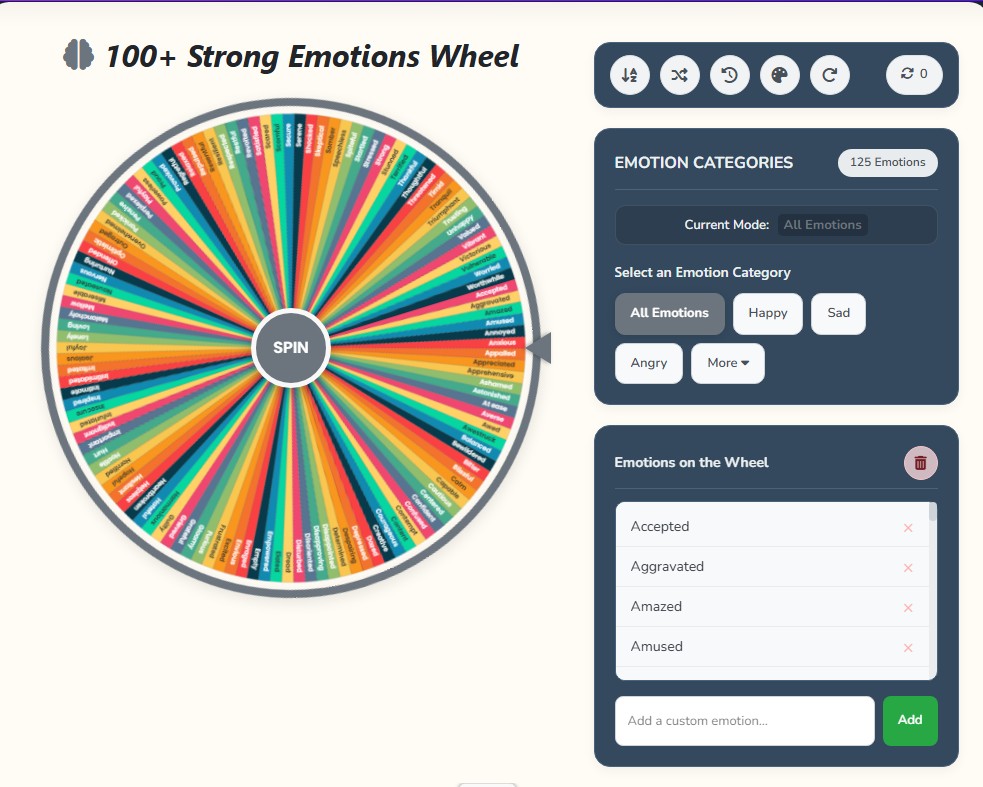
The Heart of the Wheel
At the center of your screen, you’ll find the main attraction: the vibrant, colorful wheel.
- The Wheel Canvas: This is where the magic happens. Each segment represents a different emotion, with its own unique color from the selected palette. When you choose a category, the wheel instantly populates with those specific feelings.
- The Pointer: This stationary arrow on the right side of the wheel is your selector. It patiently waits for the wheel to stop spinning to reveal your chosen emotion. 🎯
- The SPIN Button: Located right in the middle, this large, inviting button does exactly what it says. Hitting it sends the wheel into a mesmerizing spin, building anticipation for the result.
Master the Action Buttons
Above the category selector, you’ll find a sleek row of action buttons. These are your power tools for managing and personalizing your experience with the strong emotions wheel.
- Sort A-Z: Feeling a need for order? This button is your best friend. With a single click, it neatly arranges all the emotions currently on the wheel in alphabetical order. This is perfect for when you want to scan the list systematically. Ordnung! sorted!
- Shuffle: Want to leave things to chance? The Shuffle button adds a layer of spontaneity. It randomizes the order of the emotions on the wheel, ensuring that every spin is truly unpredictable. It’s a great way to break out of mental ruts. 🎲
- History: Ever wonder what your emotional patterns look like over time? The History button opens a log of your most recent spins. This feature is incredibly valuable for tracking your journey, noticing recurring feelings, and reflecting on your emotional landscape. 📜
- Color Settings: Customize the look and feel of your wheel! This button opens a settings modal where you can choose from various color palettes like Vibrant, Pastel, Earthy, and more. Match the wheel to your mood or simply pick the aesthetic you love most. 🎨
- Reset All: Need a completely fresh start? The Reset button is your go-to. It returns the tool to its original state—loading the “All Emotions” category, resetting the spin count, and clearing your history. It’s like a deep, cleansing breath for the app. 🔄
- Spin Counter: This handy little display on the right keeps track of how many times you’ve spun the wheel. It’s a simple but effective way to see how engaged you are in your self-exploration.
Dive into Emotion Categories
The true power of the strong emotions wheel lies in its ability to focus your exploration. The category selection card is designed for this very purpose.
- Category Buttons: You’ll see four main categories displayed as buttons: All Emotions, Happy, Sad, and Angry. These provide quick access to the most commonly explored emotional states. Clicking one of these instantly updates the wheel with the relevant list of strong emotions.
- The “More” Button: What about the other feelings? The “More” button elegantly houses the remaining categories (Fearful, Powerful, Peaceful, etc.) in a dropdown menu. This keeps the interface clean and uncluttered while giving you full access to the entire emotional spectrum. When you select a category from this dropdown, the “More” button will even highlight, reminding you that your active choice is from within the menu.
Customize Your Personal Wheel
This is where the tool transforms from a simple picker wheel into your personal emotions wheel. The item list box gives you complete control over what appears on the wheel.
- Adding an Emotion: Have a feeling that’s not on the list? Or maybe a specific word that resonates with you? Just type it into the “Add a custom emotion…” input box and click “Add.” It will instantly appear on both the list and the wheel. ✨
- Editing an Emotion: You can edit any emotion directly in the list! Just click on its name, and the text becomes editable. This is perfect for tweaking a word to better fit your personal definition or correcting a typo.
- Removing an Emotion: Sometimes, you want to narrow your focus. Simply click the ‘×’ button next to any emotion in the list to remove it from the wheel. This is a key feature for the “elimination” process, helping you pinpoint a specific feeling.
- Clearing the Wheel: Want to build a list from scratch? The trash can icon at the top right of the list box will clear all current emotions from the wheel, giving you a blank canvas to work with.
The Magic Behind the Spin
So, what happens after you hit that tempting SPIN button? The real fun begins!
The wheel whirls to life with a satisfying sound effect. After a few seconds of spinning, it gracefully slows down and stops, with the pointer indicating one specific emotion. But it doesn’t end there. A pop-up modal appears, presenting you with the result and three powerful options:
- Eliminate Result: This is an incredibly useful function for emotional discovery. Let’s say the wheel lands on “Annoyed,” but that doesn’t feel quite right. By clicking “Eliminate Result,” you remove “Annoyed” from the wheel and can spin again from the remaining options. It’s a process of elimination that helps you zero in on the most accurate feeling.
- Spin Again: Simple and effective. This button closes the modal and immediately starts another spin. It’s perfect for rapid-fire exploration or when you’re just having fun with the tool.
- OK: This acknowledges the result and closes the modal, returning you to the main screen. The wheel will gently auto-spin, waiting for your next command.
Putting the Wheel into Practice
The strong emotions wheel is more than just a fun gadget; it’s a versatile tool with real-world applications for personal growth and creativity.
A Tool for Self-Awareness
At its core, the wheel is a mirror for your inner world. When you’re feeling overwhelmed and can’t identify the source, a few spins can provide clarity. The landed emotion might not always be a perfect match, but it serves as a powerful prompt, guiding your thoughts toward what you’re truly experiencing. It starts a conversation with yourself.
Enhancing Emotional Intelligence
Emotional intelligence begins with vocabulary. You can’t manage what you can’t name. By regularly interacting with the 125+ strong emotions on the wheel, you are actively expanding your own emotional dictionary. This newfound vocabulary allows you to describe your feelings with greater precision to yourself and others, leading to better communication and healthier relationships.
A Resource for Creatives
Writers, actors, artists, and creators of all kinds can find immense value here. Struggling with a character’s motivation? Spin the wheel to discover a core emotion that could drive their actions. A spin landing on “Resentful” or “Inspired” could be the spark that ignites an entire storyline or a powerful performance. 🎭
A Guide for Therapeutic Growth
While not a replacement for professional help, the strong emotions wheel can be an excellent supplement to therapy and self-help practices. It provides a safe, structured way to explore difficult feelings. A therapist might use it with a client to gently probe an area of concern, or you can use it on your own for journaling prompts to dig deeper into your emotional patterns.
The journey to understanding our strong emotions is a lifelong one. With the strong emotions wheel, you have a fun, engaging, and powerful companion to guide you every step of the way. So go ahead, give it a spin, and see what you discover today! 🚀
